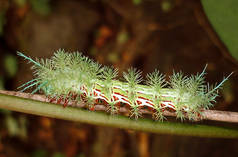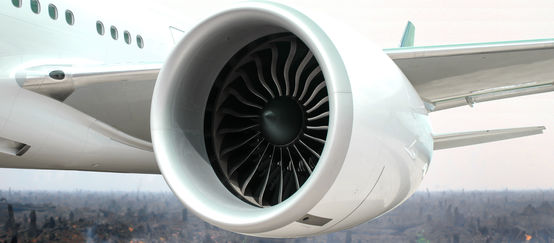Don’t trash the rainforest for “green” jet fuel!
 Airliner over a torched rainforest (montage) (© Wo st 01 / Wikimedia Commons - Montage Rettet den Regenwald - CC BY-SA 3.0 DE)
Airliner over a torched rainforest (montage) (© Wo st 01 / Wikimedia Commons - Montage Rettet den Regenwald - CC BY-SA 3.0 DE)
International aviation wants to achieve “carbon-neutral growth” by using up to 285 million tons of biofuels a year, according to the ICAO. What the industry representatives aren't saying: this will mean burning palm oil as jet fuel and destroying rainforests in the name of “green” air travel. Please speak out against this madness.
News and updates Call to actionTo: the International Civil Aviation Organization (ICAO)
“The production of aviation biofuels using palm oil would have a massive environmental impact and be anything but "green". Please scrap this misguided plan.”
Global air traffic is growing rapidly – and with it, the environmental problems caused by the aviation industry. Aircraft are currently responsible for around five percent of man-made global warming. The UN’s International Aviation Organization (ICAO) predicts that by 2050, the aviation industry's CO2 emissions will increase by a factor of five – to 2.5 billion tons annually.
The ICAO’s proposed solution: “carbon-neutral growth” – made possible by the use of biofuels. By 2025, five million tons of alternative fuels are expected to meet 2% of annual demand. The ICAO intends to reach 128 million tons a year (32%) by 2040 and 285 million tons (50%) by 2050.
The ICAO does not say how this enormous volume of biofuel will be produced. It lists algae, wood biomass and used cooking oils as possible sources. However, the necessary quantities of these raw materials – or the facilities to process them – simply do not exist.
The most likely scenario will be to use hydrotreated palm oil. Palm oil is cheap and, with a current annual production of 65 million tons, the most common vegetable oil. Neste in Finland and ENI in Italy are already producing hydrotreated biofuel in oil refineries. Others, such as the French oil giant Total, are currently building such plants.
The ICAO envisions 70 such biorefineries being set up every year, with governments launching programs to push the production of “sustainable aviation fuel”. The organization is proposing subsidies and tax incentives to offset the high production costs.
Ultimately, this will mean clearing rainforests to make room for ever more oil palm plantations – and releasing millions of tons of carbon into the atmosphere in the name of “green” air travel.
Please sign our petition to the ICAO – and avoid unnecessary air travel.
BackgroundCarbon trading
Other climate protection measures the ICAO is pursuing include trading in CO2 offsets and more efficient aircraft. However, carbon trading does not actually reduce emissions: the aviation industry is merely buying a “license to pollute” – the funds thus raised then go toward climate protection projects all over the world. Carbon trading is controversial, however, and many experts doubt that this practice has a net positive effect on the environment.
Efficiency
The potential for protecting the environment with more efficient aircraft has already been largely exhausted. The ICAO estimates the annual savings potential at 1.5 percent. However, focusing on fuel efficiency alone neglects the enormous energy consumption and material costs that go into the production of new aircraft. And while major, highly competitive airlines with new aircraft appear to be particularly environmentally friendly, the aircraft they phase out remain in service for many years with smaller, downmarket airlines. The bottom line is that the environment does not benefit.
Fuel consumption
The aviation industry requires vast quantities of fuel. In its 2010 Environmental Report, the ICAO predicts that consumption will rise from 187 million tons in 2006 to between 461 and 541 million tons in 2036. For the year 2016, the ICAO states a consumption of 260 million tons. In 2050, fuel consumption is expected to be between 700 and 900 million tons.
In its 2016 Environmental Report, the ICAO explores a variety of scenarios with regard to fuel consumption. According to the report, meeting the demand for aviation biofuel would mean building 170 biofuel refineries every year and an a cost of up to $60 billion annually.
Climate impact of the aviation industry
The ICAO and the aviation industry use creative accounting to minimize their climate impact. According to the Air Transport Action Group, an industry association, aircraft account for two percent of man-made CO2 emissions worldwide.
By contrast, independent scientific studies conclude that the aviation industry accounts for five percent of man-made climate change: In addition to CO2, aircraft emit other climate-relevant pollutants such as nitrogen oxides, sulfur oxides and water vapor. Emissions at an altitude of about 10 kilometers have different effects and are far more persistent (many years) than pollutants emitted at ground level. For example, the water vapor emitted by the aircraft – part of which is often briefly visible as a condensation trail – contributes to the warming of the atmosphere. The water droplets remain in the atmosphere long after the condensation trails vanish. In addition to flight kilometers, the climate-relevant emissions caused by airports must also be taken into account. These effects are not eliminated by biofuel.
Oilseed crops are not an alternative
The aviation industry’s ITAKA Project has shown how difficult it is to produce even small amounts of biofuel for test flights. The project, which was subsidized by the EU to the tune of €10 million, is experimenting with the cultivation of an oilseed crop, Camelina sativa, in Spain and Rumania. Marginal soils were used to reduce competition with food crops.
Experimental farms in the Castilla La Mancha and Aragon regions yielded from 182.5 to 292 liters of camelina oil per hectare. The project operators claim that yields of more than 730 liters per hectare would be possible on fertile soils. Based on camelina oil’s density of 0.92 kg/l, this amounts to a yield of 0.672 tons per hectare (t/ha). To put that into perspective, sunflower yields 0.86 t/ha and rapeseed 1.33 t/ha. Approximately 2,000 tons of camelina oil were produced on a total area of 10,500 hectares, as can be calculated from the project specifications.
Since the amount was not enough for the desired test flights, additional camelina oil was purchased in the United States. Used cooking oil (UCO) has also been used to produce aviation biofuel. However, the project operators state that UCO cannot be regarded as a primary raw material due to the limited quantities available and the fact that they are already being used in other sectors. The project appears to have since been abandoned.
Palm oil
The raw oils were processed into hydrotreated vegetable oil (HVO) and hydroprocessed esters and fatty acids (HEFAs) in the refineries of project partner Neste Oil. Hydrotreatment is the only method currently in large-scale commercial use that can produce biofuel suitable for use in aircraft, as the properties of hydrotreated vegetable oils are very similar to fossil kerosene. Biodiesel (fatty acid methyl ester – FAME) is not suitable as aviation fuel.
Hydrotreatment methods can be used in existing oil refineries as well as dedicated plants. Neste Oil already operates four major HVO refineries: two plants with a capacity of 190,000 tons each in Finland, and two with a capacity of 800,000 tons each in Rotterdam and Singapore. According to Neste Oil’s 2015 annual report, the main raw materials used were 870,000 tons of crude palm oil (CPO) and 1.93 million tons of waste – animal fats and palm fatty acid distillate (PFAD).
Italy’s ENI and the Spanish oil companies Repsol and Cepsa are also producing HVO from palm oil. Total, a French oil and gas company, is building an HVO refinery in the harbor of Marseilles. The refineries are all located in major harbors, facilitating the delivery of palm oil from overseas.
Further information
Website of the Second ICAO Conference on Aviation and Alternative Fuels (CAAF2)
ICAO, August 18, 2017: Estimated Prices of Aviation Alternative Fuels
ICAO, August 27, 2017: Proposed ICAO Vision on Aviation Alternative Fuels
Articles
Biofuelwatch: The high-flown fantasy of aviation biofuels
Transport & Environment: Aviation emissions and the Paris Agreement
Studies
Biofuelwatch, Okt. 2017: Aviation biofuels:How ICAO and industry plans for'sustainable alternative aviation fuels'could lead to planes flying on palmoil
FERN, Sept. 27, 2016: International declaration denounces ICAO offset plan
FERN, Sept. 9, 2016: Cheating the climate: the problems with aviation industry plans to offset emissions
Oakland Institute: Eco-skies - the global rush for aviation biofuel
Friends of the Earth: Flying in the face of the facts - Greenwashing the aviation industry with biofuels
Lee et.al.: Aviation and global climate change in the 21st century
To: the International Civil Aviation Organization (ICAO)
Ladies and Gentlemen,
We welcome the aviation industry’s concern about its environmental impact. However, your plans in their present form – carbon trading and the use of biofuels – will not contribute to reducing it.
Carbon trading and the financing of carbon-offsetting initiatives will not reduce aircraft emissions. Carbon trading means paying to shift the responsibility for reducing emissions onto others.
Producing large quantities of aviation biofuel will almost inevitably require hydrotreated palm oil, yet the palm oil industry destroys rainforests for its plantations, releasing vast amounts of carbon.
All of the remaining production processes and raw materials being considered by the ICAO for the production of biofuels are not feasible.
We therefore consider your plans for “carbon-neutral growth” to be a deception of the public. The only truly environmentally friendly solution is a reduction in air traffic.
Kind regards,
The issue – rainforest on our dinner tables and in our fuel tanks
At 66 million tons annually, palm oil is the most commonly produced vegetable oil. Its low world market price and properties that lend themselves to processed foods have led the food industry to use it in half of all supermarket products. Palm oil can be found in frozen pizzas, biscuits and margarine, as well as body creams, soaps, makeup, candles and detergents.
Few people realize that almost half of the palm oil imported into the EU is used as biofuel. Since 2009, the mandatory blending of biofuels into motor vehicle fuels has been a major cause of deforestation.
Oil palm plantations currently cover more than 27 million hectares of the Earth’s surface. Forests and human settlements have been destroyed and replaced by “green deserts” containing virtually no biodiversity on an area the size of New Zealand.
The impact – suffering and death in producer countries, climate havoc
The warm, humid climate of the tropics offers perfect growth conditions for oil palms. Day after day, huge tracts of rainforest in Southeast Asia, Latin America and Africa are being bulldozed or torched to make room for more plantations, releasing vast amounts of carbon into the atmosphere. As a consequence, Indonesia – the world’s largest producer of palm oil – temporarily surpassed the United States in terms of greenhouse gas emissions in 2015. With their CO2 and methane emissions, palm oil-based biofuels actually have three times the climate impact of traditional fossil fuels.
Palm oil is not only bad for the climate: As their forest habitat is cleared, endangered species such as the orangutan, Borneo elephant and Sumatran tiger are being pushed closer to extinction. Smallholders and indigenous people who have inhabited and protected the forest for generations are often brutally driven from their land. In Indonesia, more than 700 land conflicts are related to the palm oil industry. Human rights violations are everyday occurrences, even on supposedly “sustainable” and “organic” plantations.
As consumers, we are largely unaware of these broader issues, yet our daily palm oil consumption also impacts our health: refined palm oil contains large amounts of harmful fatty acid esters that are known to damage DNA and cause cancer.
The solution – a revolution on our dinner tables and in our fuel tanks
Only 70,000 orangutans still roam the forests of Southeast Asia, yet the EU’s biofuels policy is pushing them to the brink of extinction. Every new plantation on Borneo is destroying a further piece of their habitat. Stepping up the pressure on policymakers is a must if we want to save our tree-dwelling kin. Apart from that, however, there is still a lot we can do in day-to-day life.
Follow these simple tips to recognize, avoid and combat palm oil:
- Enjoy a home-cooked meal: Use your imagination: why not try almond-coconut-pear biscuits? Or pizza with potato and rosemary? A meal cooked from fresh ingredients beats processed foods containing palm oil every time. Oils such as sunflower, olive, rapeseed or flaxseed are ideal for cooking and baking.
- Read labels: As of December 2014, labeling regulations in the EU require food products to clearly indicate that they contain palm oil. However, in the case of non-food items such as cosmetics and cleaning products, a wide range of chemical names may still be used to hide the use of palm oil. A quick check of your favorite search engine will turn up palm oil-free alternatives, however.
- Remember that the customer is king: Ask your retailers for palm oil-free products. Write product manufacturers and ask them why they aren’t using domestic oils. Companies can be quite sensitive to issues that give their products a bad name, so inquiring with sales staff and contacting manufacturers can make a real difference. Public pressure and increased awareness of the problem have already prompted some producers to stop using palm oil.
- Sign petitions and write your elected representatives: Online campaigns put pressure on policymakers responsible for biofuels and palm oil imports. Have you already signed all of Rainforest Rescue’s petitions?
- Speak out: Protest marches and creative action on the street raise public and media awareness of the issue, which in turn steps up the pressure on policymakers.
- Leave your car at home: Whenever you can, walk, ride a bicycle or use public transport.
- Be informed and inform others: Big Business and governments would like us to believe that biofuels are good for the climate and that oil palm plantations are sustainable. Spread the word – share this information with your family and friends and encourage them to rethink their consumption habits. It’s in our hands!
This petition is also available in the following languages:
Help us reach 250,000:











